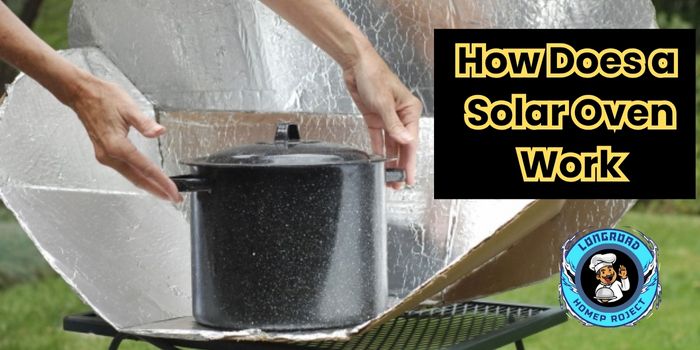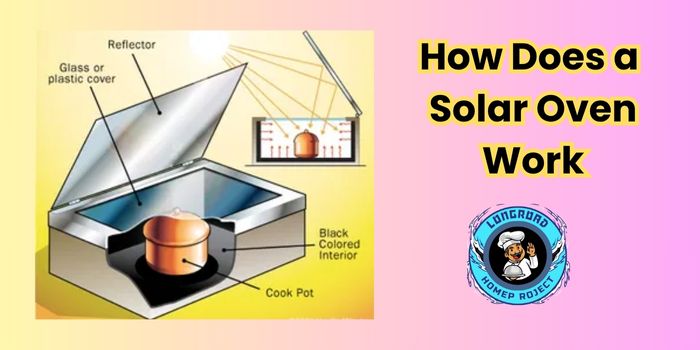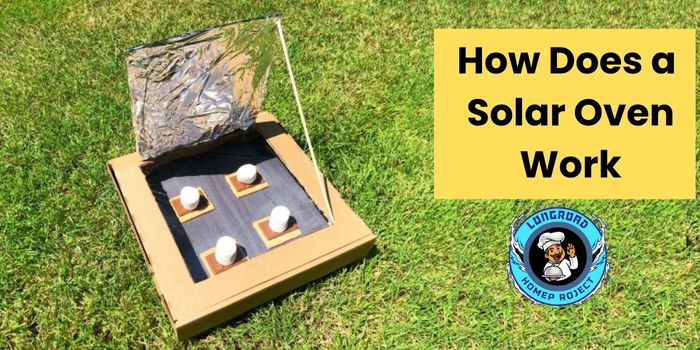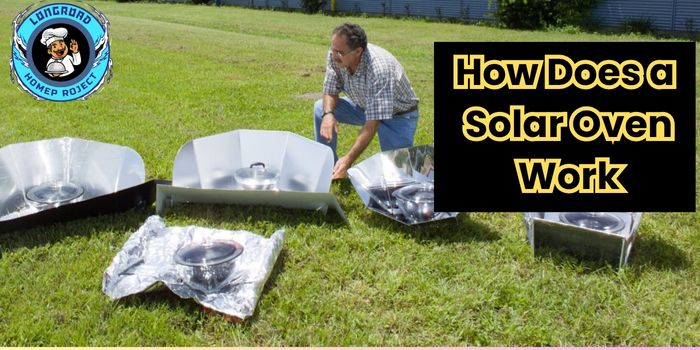As an Amazon Associate I earn from qualifying purchases.
How does a solar oven work? I found out the fun way—by accidentally baking brownies under the Arizona sun during a camping trip with friends. No electricity. No firewood. Just a homemade cardboard box, aluminum foil, and the scorching desert heat. To our surprise, that DIY solar oven cooked those brownies to perfection—crisp edges and all.
Since then, I’ve been fascinated by the science and simplicity behind solar cooking. It’s more than a quirky science project; it’s a practical, sustainable way to harness the sun’s energy—whether you’re off-grid, camping, or just curious about renewable living.
In this article, we’ll break down how solar ovens work—step by step and in plain English. You’ll learn the physics behind how heat gets trapped, how solar cookers collect and concentrate energy, and why they’re more effective than you might think. We’ll also cover the pros and cons, explore common myths, and answer questions like:
- Can you cook real meals in a solar cooker?
- What are the downsides?
- Is it safe for kids or classrooms?
Whether you’re prepping for a school science fair, looking to save energy, or just love a clever outdoor cooking trick, this guide will walk you through everything you need to know.
So grab your curiosity (and maybe a recipe), and let’s shine some light on solar ovens.
What Is a Solar Oven?
A solar oven is a device that uses the energy from sunlight to cook food—without electricity, gas, or fire. In simple terms, it works like a slow cooker powered by the sun. Instead of using a flame or heating element, it collects and traps heat from sunlight to reach cooking temperatures. No plugs, no fuel—just sunshine.
What Can You Cook in a Solar Oven?
Wondering if you can cook normal food in a solar cooker? Absolutely. You can bake bread, roast vegetables, boil rice, or even slow-cook stews and meats. Many solar ovens can reach temperatures between 250°F and 400°F (120°C–200°C)—hot enough to handle everyday meals. Some people even bake cookies, brownies, and pizza.
Solar ovens are popular in:
- Off-grid living (homesteads, RVs, van life)
- Emergency situations (natural disasters, blackouts)
- Developing regions (where fuel is expensive or scarce)
- Eco-conscious homes (for zero-emission cooking)
- Science classrooms and fairs (solar oven science projects)
Types of Solar Ovens
There are three main types of solar cookers. Each uses sunlight a little differently but follows the same basic idea: capture, concentrate, and retain heat.
Box Cookers
These look like insulated boxes with a glass lid and reflective panels. They trap heat inside and are ideal for baking or slow-cooking. Great for beginners or classroom experiments.
Popular for solar oven science projects due to their simple design and ease of construction.
Parabolic Cookers
These have a curved, satellite-dish shape that focuses sunlight onto a single point (like a stovetop burner). They can get very hot, very fast—great for frying or boiling, but they require careful handling.
Panel Cookers
These use multiple flat reflectors to angle sunlight onto a central pot, usually inside a heat-safe bag or container. They’re lightweight and affordable, but best suited for low-temp, slow cooking.
Why Do People Use Solar Ovens?
Here’s why solar ovens are gaining popularity around the world:
- ✅ Eco-Friendly: No emissions, fuel, or electricity required
- ✅ Cost-Saving: Free to use—forever
- ✅ Safe: No open flame or hot coils
- ✅ Portable: Great for camping or travel
- ✅ Educational: Ideal for hands-on learning about energy and sustainability
From science experiments to real-world survival gear, solar ovens are more than just a fun gadget—they’re a practical tool for cleaner, smarter cooking.

How Does a Solar Oven Work – In Simple Terms
How does a solar oven work in simple terms? Think of it like a parked car on a hot summer day. You know how the inside of a car can feel like an oven—even hotter than the air outside? That’s solar heating in action. The car’s windows let sunlight in, but the heat gets trapped inside. A solar oven works the same way—only with better engineering (and tastier results).
At its core, a solar oven does three things:
- Reflects sunlight
- Traps heat inside
- Retains and concentrates that heat to cook food
Sunlight Becomes Heat Energy
The process starts when sunlight hits the reflective surfaces of the solar oven—like shiny panels or mirrors. These reflect and focus the sunlight onto a small, targeted area, usually where the cooking pot or tray sits.
- Just like a magnifying glass can focus sunlight to burn paper, a solar oven concentrates solar energy into heat.
Heat Gets Trapped
That focused light enters the oven’s cooking chamber—often a box or an enclosed space with a transparent lid. This design lets in sunlight but prevents heat from escaping easily, much like how your car windows let in light but trap the hot air.
- This is called the greenhouse effect, and it’s the same principle used in greenhouses and planet Earth’s atmosphere.
Heat Is Retained for Cooking
The inside of a solar oven is usually insulated with dark-colored materials that absorb heat and hold onto it. The pot or pan inside also helps retain and distribute the warmth. Over time, the oven reaches cooking temperatures—sometimes over 350°F (175°C), depending on the model and sunlight intensity.
- The result? Food that bakes, boils, or stews—without any flames, gas, or electricity.
Real-Life Comparison: A Solar Oven Is Like…
- A car on a hot day (sunlight in, heat trapped inside)
- A slow cooker (low, steady heat over time)
- A mini greenhouse for your food
This simple but powerful concept is what makes solar ovens both effective and eco-friendly. And once you understand the basic physics behind it, you’ll start seeing solar energy opportunities everywhere—from school projects to survival prep and sustainable living.
Step-by-Step: How a Solar Oven Works
If you’re wondering how does a solar oven work step by step, here’s a simple breakdown of the process—from sunlight to supper. Each step works together to collect, convert, and trap heat, allowing your food to cook without any fuel or flame.
Light Collection – Gathering Sunlight with Reflectors
Solar ovens use reflective panels—often made from shiny foil, polished metal, or mirrors—to catch and focus sunlight. These reflectors aim the sun’s rays directly into the cooking chamber.
- Think of it like a satellite dish catching signals, but instead, it’s concentrating light.
- The more sunlight you collect, the hotter the oven can get.
This step is all about directing energy efficiently into the oven.
Light Conversion – Turning Light into Heat
Once the sunlight hits the interior of the oven (usually lined with dark materials), something cool happens: the light transforms into heat. This is called thermal energy conversion.
- Dark surfaces absorb more light and heat than light-colored ones.
- That’s why the inside of most solar ovens is painted black—it helps convert light faster and hold warmth.
This step powers the oven without plugs, wires, or fuel.
Heat Trapping – Insulation Locks in Warmth
After the heat is created, it needs to be trapped and retained. The oven chamber is usually covered with a clear lid or glass panel, and surrounded by insulation (like foam, cardboard, or air pockets).
This creates a mini greenhouse effect, just like a warm car interior or an actual greenhouse.
- Heat comes in, but doesn’t escape easily.
- The sealed design keeps hot air circulating around your food.
This step ensures the oven maintains a steady internal temperature.
Temperature Build-Up – Cooking Begins
As more sunlight enters and more heat is trapped, the internal temperature rises. While it won’t cook as fast as your kitchen oven, most solar ovens can reach 250°F to 375°F (120°C to 190°C)—perfect for slow-cooking, baking, or warming food.
- Cooking times depend on the sun’s intensity, time of day, and oven design.
- Expect about 1.5x to 2x the time of a regular oven—but no energy bill!
In this final step, your food is baked or boiled to perfection—naturally.

Solar Oven Diagram
Include a labeled diagram with the following parts:
- Reflectors catching sunlight
- Sunlight entering the transparent lid
- Dark cooking surface absorbing heat
- Insulated box containing warm air
- Cooking pot placed inside
Label each part clearly to help visual learners understand how energy flows through the system.
The Physics Behind Solar Ovens
Ever wondered how does a solar oven work, physics-wise? It might seem like magic, but it’s pure science—rooted in basic principles of light, heat, and energy transfer. Here’s how a solar oven collects and concentrates enough thermal energy to cook food, all thanks to a few key laws of physics.
Reflection: Directing Sunlight Where It’s Needed
Solar ovens use reflective surfaces (like mirrors or foil) to bounce sunlight toward a central cooking area. This is known as specular reflection, and it’s the same principle behind how a flashlight reflector concentrates a beam of light.
- More reflection = more focused sunlight = higher cooking temperatures.
Physics Connection: Light travels in straight lines and bounces off shiny surfaces at predictable angles—letting us aim sunlight like a laser toward the food.
Absorption: Turning Light into Heat
When light hits a dark surface, it gets absorbed instead of bouncing away. This is called black-body absorption—a key reason most solar oven interiors and cookware are painted black.
- Black surfaces absorb all wavelengths of visible light, turning that energy into heat.
- This heat then radiates into the cooking chamber and the food itself.
Real-life example: That’s why wearing black clothes on a hot day makes you feel warmer—you’re absorbing more solar radiation.
Insulation: Keeping the Heat In
Once heat is generated, it needs to be trapped—and that’s where insulation comes in. Most solar ovens have double walls, foam padding, or air layers that slow the escape of heat through conduction or convection.
- The transparent lid (glass or plastic) allows sunlight in but helps hold heat inside—like the greenhouse effect.
- Heat energy is kept close to the food, allowing it to cook slowly but surely.
Fun fact: Greenhouses, parked cars, and even sealed jars in the sun work the same way.
Radiation: Heating the Food
As the cooking chamber warms up, it radiates infrared heat—a type of electromagnetic energy that warms the food directly. This is called thermal radiation, and it works even without direct contact.
- Your food absorbs this heat and starts to cook, just like in an oven.
- Radiation is gentle and even—making solar ovens perfect for baking, simmering, or slow-roasting.
Why Dark Cookware Works Best
Using dark, non-reflective pots and pans helps maximize heat absorption. The darker and heavier the cookware, the better it soaks up solar energy and retains heat.
- Avoid shiny or reflective cookware—it reflects sunlight away instead of absorbing it.
- Materials like cast iron, graniteware, or black ceramic are ideal.
Bringing It All Together
So, to summarize the physics behind solar ovens:
- Reflect sunlight toward a focal point
- Absorb light with dark surfaces
- Insulate to trap and retain heat
- Radiate energy to cook food evenly
It’s simple science with powerful potential. No wires. No fuel. Just nature and a little ingenuity—turning sunlight into supper.
Can You Really Cook Normal Food in a Solar Oven?
Can you cook normal food in a solar cooker? Yes—absolutely. In fact, once you understand how to work with sunlight and timing, a solar oven can handle most everyday meals. I’ve personally used mine to bake bread, simmer hearty stews, cook eggs, and even make gooey chocolate chip cookies on a sunny afternoon.
What I’ve Cooked in a Solar Oven
- Rustic sourdough bread: Took about 2.5 hours, came out golden with a crunchy crust
- Vegetable stew: Slow-cooked with tender results and deep flavor
- Baked eggs with herbs: Perfect for brunch or camping
- Chocolate chip cookies: Slightly chewy, soft, and sun-sweetened
Solar ovens don’t limit what you can cook—they just shift the way you cook it. Think of them like outdoor slow cookers or convection ovens. They use gentle, radiant heat that builds gradually, so your food cooks more evenly and retains moisture.
Cooking Times: Solar vs. Conventional Ovens
| Dish | Solar Oven Time | Conventional Oven Time |
|---|---|---|
| Bread Loaf | 2–3 hours | 45–60 minutes |
| Stew or Soup | 2–4 hours | 1–1.5 hours |
| Cookies (dozen) | 45–90 minutes | 10–15 minutes |
| Scrambled/Baked Eggs | 30–60 minutes | 10–15 minutes |
| Brown Rice | 1.5–2 hours | 45 minutes |
Note: Times vary by sun intensity, time of day, and oven type.
Best Foods for Solar Cooking
Some recipes just shine (pun intended) in a solar oven:
- Soups & stews
- Rice & grains
- Casseroles
- Vegetables (especially root veggies)
- Muffins, cakes, and cookies
- Hard-boiled or baked eggs
Tips for Best Results
To get the most out of your solar cooker:
- ✅ Use dark, shallow cookware for better heat absorption
- ✅ Preheat your oven just like a regular oven, if possible
- ✅ Cut food into smaller pieces for faster, more even cooking
- ✅ Avoid thick cuts of meat unless you’re using a parabolic cooker (which reaches higher temps faster)
- ✅ Track the sun’s angle and rotate the oven every 30–45 minutes for consistent heat
Ideal Solar Oven Recipes (Try These First)
- Solar-baked mac & cheese
- Black bean and sweet potato chili
- Garlic-roasted carrots and potatoes
- Honey cornbread
- Sun-powered banana muffins
- Mediterranean eggplant bake
Solar cooking isn’t about limitations—it’s about transformation. Once you adapt to the rhythm of the sun, you’ll be amazed at how versatile, flavorful, and satisfying your solar-cooked meals can be.

Drawbacks of a Solar Oven
You might be wondering, what are the drawbacks of a solar oven? While they’re eco-friendly and cost-effective, solar cookers do have a few limitations that can catch new users off guard. But here’s the good news: most of these downsides are easy to work around with a little planning.
Let’s look at the common challenges—and smart ways to solve them.
Weather-Dependent
Problem: Solar ovens need strong, direct sunlight to work effectively. On cloudy days, during winter, or in shaded areas, your cooking results may suffer—or stop entirely.
Workaround:
- ✅ Check the forecast before planning a solar meal
- ✅ Use solar cooking primarily from late spring to early fall
- ✅ Keep a backup cooking method handy (like a camp stove or electric hot plate)
- ✅ Consider a hybrid solar cooker, which includes an electric element for cloudy days
Slower Cook Times
Problem: Solar ovens cook food more slowly than conventional ovens or stoves. A loaf of bread that takes 40 minutes in your kitchen may take 2–3 hours outdoors.
Workaround:
- ✅ Use your solar oven for slow-cooked meals (stews, casseroles, baked goods)
- ✅ Start earlier in the day, ideally between 10 a.m. and 2 p.m. for peak sunlight
- ✅ Prep ingredients the night before so you can begin cooking as soon as the sun is strong
- ✅ Use smaller, thinly sliced portions of meat or veggies to speed things up
Limited Temperature Control
Problem: You can’t just “set it to 350°F” like a kitchen oven. Temperature depends on sunlight intensity, angle, and the efficiency of your cooker.
Workaround:
- ✅ Use a built-in or external thermometer to monitor internal temperature
- ✅ Rotate the oven every 30–45 minutes to keep it aligned with the sun
- ✅ Adjust reflector angles to increase or decrease heat exposure
- ✅ Choose recipes that are forgiving of temperature variation, like muffins, soups, or grains
Bonus: Wind Can Be an Issue
Problem: Wind gusts can blow lightweight solar ovens out of position—or even knock them over.
Workaround:
- ✅ Anchor your cooker with stakes or sandbags
- ✅ Set it up near a windbreak (fence, wall, tent, or vehicle)
- ✅ Choose sturdier designs with a low center of gravity for windy conditions
Pro Tip: Combine Solar with Traditional Cooking
For busy days or complex meals, try hybrid cooking:
- Start cooking in the solar oven to save energy
- Finish on a stove or grill if needed
- Pre-cook meats indoors, then reheat or finish outdoors in the solar cooker
This way, you enjoy the energy savings without being held hostage by the weather.
Solar ovens aren’t perfect, but with the right expectations and a few clever strategies, you can overcome the downsides and cook confidently—even under the sun.
FAQs
How does a solar oven trap heat?
A solar oven traps heat by using a transparent lid or glass cover to let sunlight in while preventing the heat from escaping—similar to a greenhouse. The interior is usually insulated and lined with dark surfaces that absorb and retain the heat.
Can I use a solar oven on cloudy days?
Not effectively. Solar ovens work best under direct sunlight. On cloudy or overcast days, the temperature inside may not get hot enough to cook food safely. For overcast days, use a backup cooking method or consider a hybrid solar-electric model.
How hot can a solar oven get?
Most standard solar ovens reach between 250°F and 375°F (120°C to 190°C) on a sunny day. Parabolic models can exceed 400°F (204°C). The exact temperature depends on the sun’s intensity, your location, and the oven’s design.
Is it safe to cook meat in a solar oven?
Yes, but it must reach and maintain a safe internal temperature. Use a meat thermometer to ensure poultry hits 165°F (74°C) and beef/pork reaches 145°F (63°C). Cut meat into smaller pieces or use a parabolic cooker for faster, safer results.
How long does food take to cook?
Cooking time depends on the dish, sunlight, and oven design. On average:
- Cookies: 45–90 minutes
- Bread: 2–3 hours
- Stew or rice: 2–4 hours
- Hard-boiled eggs: 30–60 minutes
Solar ovens are best for slow cooking—similar to a crockpot.
Do solar ovens work in winter?
Yes, but only when there’s strong direct sunlight. Cold air doesn’t prevent solar heating—as long as the sun is shining. However, cooking times may increase due to weaker sun angles and shorter daylight hours.
Can kids use a solar oven for science projects?
Absolutely! Solar ovens are great for STEM learning. They teach energy transfer, sustainability, and real-world physics. Kids can safely cook s’mores, melt crayons, or make mini pizzas with adult supervision. They’re a fun and educational hands-on activity.
What materials do I need to build a DIY solar cooker?
To build a basic DIY solar cooker, you’ll need:
- A cardboard box or pizza box
- Aluminum foil (for reflectors)
- Plastic wrap or clear glass (to trap heat)
- Black construction paper (to absorb light)
- Tape, scissors, and glue
- Optional: thermometer, small black pot
Perfect for school projects or backyard experiments!
Conclusion
So, how does a solar oven work? At its core, it’s a beautiful blend of simple science and natural energy. By using sunlight to reflect, trap, and retain heat, a solar oven turns the power of the sun into a safe, sustainable way to cook everything from stew to cookies—no gas, no grid, no guilt.
Whether you’re camping, prepping for emergencies, teaching science to your kids, or just exploring greener living, solar ovens offer a real-life solution that’s eco-friendly, educational, and often surprisingly fun.
And the best part? Anyone can do it. With just a few materials or a store-bought model, you can start solar cooking with zero experience and very little cost.
As an Amazon Associate I earn from qualifying purchases.
